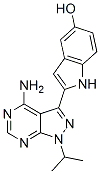We found that ZFNs undergo proteasomal degradation and that MG132 increases ZFN levels, leading to enhanced genetic modifications by the ZFNs. Our protein stability study should lay the foundation for the advancement of ZFN technology; furthermore, the identification of MG132 as a small molecule that increases ZFN function is expected to facilitate the use of ZFNs. Targeted genetic modification using ZFNs can enable targeted gene insertion, correction, disruption, chromosomal rearrangement,  and regulatory region alteration. Gene editing using ZFNs is a promising technology as a powerful tool for studying biological processes and for the development of R428 advanced gene therapy to correct pathogenic genes. Here for the first time we investigated ZFN stability. Given that high levels of ZFN protein are associated with enhanced ZFN activity, our protein stability study should lay the foundation for further development of ZFN technology. Furthermore, ZFNs can be now delivered directly as protein and several doses of ZFN protein treatment are required to obtain sufficient ZFN activity, because the ZFNs are degraded within a few hours after treatment. Thus, the development of methods to maintain sufficient ZFN concentrations is important; our protein stability study should serve as a basis for this research. Even when a ZFN protein is continuously expressed by a DNA vector transfected into the target cells, inhibition of ZFN degradation increased the ZFN protein levels, leading to enhanced genetic modification. Porteus�� group has PB 203580 supply previously reported that short-term exposure to MG132 does not significantly increase the protein levels and activity of ZFNs that contain wild-type FokI nucleases. In contrast, we observed that MG132 treatment increased ZFN activity 2.4 or 2-fold. One possible reason for this discrepancy could be the different FokI nucleases employed in the two experiments: the ZFN used by Porteus�� group contained the wildtype FokI nuclease, whereas we used ZFNs with a modified FokI nuclease, which is improved from the wild type and is now predominantly used. This difference in the ZFN amino acid sequence might affect the rate of ZFN proteolysis. Another reason could be the difference in the MG132 concentration and duration of exposure: we treated cells with MG132 for 60 hours at 1, 2, and 5 mM, whereas Porteus�� group used 10 mM of MG132 for only 4 hours. We observed significantly decreased cell viability at 10 mM of MG132 when cells were treated for 60 hours. In addition, the application of MG132 to human embryonic stem cells caused cytotoxic effects even at very low dosage, which is compatible with the previous reports that showed similar cytotoxic effects of MG132 on hESCs. Here we showed that ZFN activity can be enhanced using a small molecule, MG132. To our knowledge, this is the first study reporting that a small molecule can regulate ZFN function. Identifying small molecules with this property is important given that ZFN technology is actively being studied as a tool for gene therapy and to analyze biological processes. Although MG132 is not a FDA-approved drug, other FDA-approved proteasomal inhibitors such as bortezomib might be used together with ZFNs to enhance the effect of gene therapy. Indeed, it has been recently reported that bortezomib can increase the effect of a ZFN-expressing adeno-associated virus.
and regulatory region alteration. Gene editing using ZFNs is a promising technology as a powerful tool for studying biological processes and for the development of R428 advanced gene therapy to correct pathogenic genes. Here for the first time we investigated ZFN stability. Given that high levels of ZFN protein are associated with enhanced ZFN activity, our protein stability study should lay the foundation for further development of ZFN technology. Furthermore, ZFNs can be now delivered directly as protein and several doses of ZFN protein treatment are required to obtain sufficient ZFN activity, because the ZFNs are degraded within a few hours after treatment. Thus, the development of methods to maintain sufficient ZFN concentrations is important; our protein stability study should serve as a basis for this research. Even when a ZFN protein is continuously expressed by a DNA vector transfected into the target cells, inhibition of ZFN degradation increased the ZFN protein levels, leading to enhanced genetic modification. Porteus�� group has PB 203580 supply previously reported that short-term exposure to MG132 does not significantly increase the protein levels and activity of ZFNs that contain wild-type FokI nucleases. In contrast, we observed that MG132 treatment increased ZFN activity 2.4 or 2-fold. One possible reason for this discrepancy could be the different FokI nucleases employed in the two experiments: the ZFN used by Porteus�� group contained the wildtype FokI nuclease, whereas we used ZFNs with a modified FokI nuclease, which is improved from the wild type and is now predominantly used. This difference in the ZFN amino acid sequence might affect the rate of ZFN proteolysis. Another reason could be the difference in the MG132 concentration and duration of exposure: we treated cells with MG132 for 60 hours at 1, 2, and 5 mM, whereas Porteus�� group used 10 mM of MG132 for only 4 hours. We observed significantly decreased cell viability at 10 mM of MG132 when cells were treated for 60 hours. In addition, the application of MG132 to human embryonic stem cells caused cytotoxic effects even at very low dosage, which is compatible with the previous reports that showed similar cytotoxic effects of MG132 on hESCs. Here we showed that ZFN activity can be enhanced using a small molecule, MG132. To our knowledge, this is the first study reporting that a small molecule can regulate ZFN function. Identifying small molecules with this property is important given that ZFN technology is actively being studied as a tool for gene therapy and to analyze biological processes. Although MG132 is not a FDA-approved drug, other FDA-approved proteasomal inhibitors such as bortezomib might be used together with ZFNs to enhance the effect of gene therapy. Indeed, it has been recently reported that bortezomib can increase the effect of a ZFN-expressing adeno-associated virus.